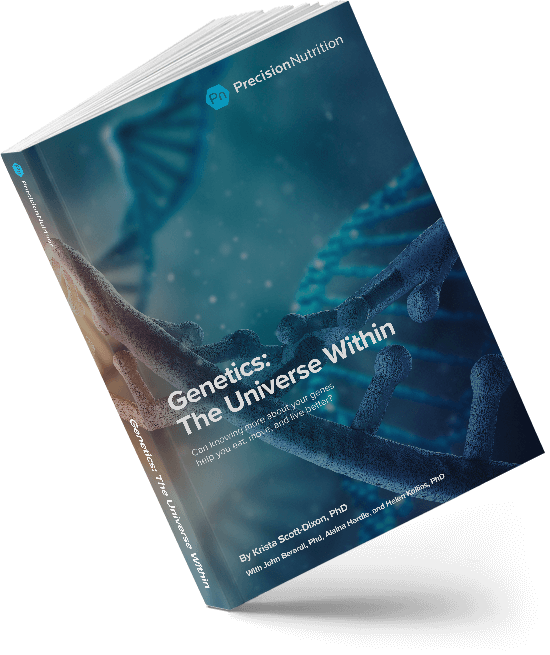Chapter 13
Glossary of terms
#
6-n-propylthiouracil (PROP): A compound that tastes bitter to some people, but is tasteless to others; the ability to detect it is genetically determined.
A
Absolute risk: In terms of health conditions, the prevalence of a disease within an entire population (e.g., 3% of all people will get Disease X in their lifetime).
Actin: A protein within muscle tissue.
Adenine: One of the nucleotides that forms DNA / RNA, along with cytosine, guanine, and thymine (uracil in RNA). Often abbreviated as A. In base pairing, adenine pairs with thymine (T) and uracil (U).
Adipocyte: A fat cell.
Adiponectin: A protein produced in adipose (fat) tissue that helps to regulate many processes, including glucose metabolism and fatty acid oxidation.
Alkaline lysis: A process for breaking down cell membranes in order to extract genetic material, using a base like sodium hydroxide and a surfactant.
Allele: A variant of the same gene (usually emerging through mutation), found at the same place on the chromosome.
Allelic heterogeneity: When related genetic variants, or alleles, in the same location are associated with the same trait or outcome.
Allergen: Something that causes a histamine response, known as an immunoglobulin E (IgE) immune reaction.
Allergy: A hypersensitive immune system response.
Amino acid: The basic building block for a protein.
Amplicon: A piece of DNA or RNA that has been amplified or copied, especially through the polymerase chain reaction (PCR).
Amplicon sequencing: A technique that uses the polymerase chain reaction (PCR) to make billions and billions of copies of a previously-identified stretch of DNA, and sequence these copies (known as amplicons).
Amplification: An increase in the number of copies of a gene, possibly along with the RNA and protein made from that gene. Gene amplification is common in cancer cells.
Anabolism: Metabolic pathways of molecular and tissue growth, synthesis, and development. Opposite of catabolism.
Androgen insensitivity syndrome (AIS): A type of intersexuality that happens when a chromosomally male (XY) body does not respond to masculinizing hormones (i.e., androgens), and develops with a body that looks female.
Antibody: A type of protein that is produced by the immune system when it identifies a foreign substance, known as an antigen. Antibodies help identify pathogens (such as bacteria or viruses) as well as allergens and toxins.
Antigen: Any foreign substance that stimulates an immune response, particularly antibody production.
Antigen-presenting cells: Cells that tell other cells of the immune system (such as T cells) that there’s trouble spotted (such as a pathogen), and it’s time to go to work.
Apolipoproteins: Protein-based components of lipoproteins. They’re encoded by genes that start with the letters APO (such as APOB or APOE).
Apoptosis: Programmed cell death.
Assay: A method for determining the presence or quantity of a particular component, or a method to analyze or quantify a particular substance in a sample.
Autoimmune thyroid disease (AITD): A form of thyroid disease in which the body attacks normally healthy thyroid tissue.
Autonomic nervous system (ANS): The branch of the nervous system that controls basic functions such as heart rate and breathing.
Autosomal dominant: A form of inheritance in which you need only one copy of a gene from a parent to express a trait.
Autosomal recessive: A form of inheritance in which you need two copies of a gene (one from each parent) to express a trait.
Avenins: A protein in oats that is similar to gluten in wheat, and which can cause an immune system reaction in some people.
B
Bamforth–Lazarus syndrome: A rare genetic disease in which thyroid tissue is underdeveloped or missing entirely.
Basal metabolic rate (BMR): The body’s “idling speed”, i.e., the rate at which metabolic reactions take place and use energy to do so.
Base excision repair (BER): A method that our cells use to repair damaged DNA.
Base pair: A pair of complementary nucleotides (bases) on a strand of DNA or RNA.
β-adrenergic receptors: Receptors that respond to catecholamine hormones like adrenaline, and activate processes to help us free up stored energy, get our muscles moving, and do other autonomic nervous system jobs.
Bioactive form: A form of a molecule or compound that has an effect on a biological organism (e.g., “Before we can absorb Substance X, it must be converted into its bioactive form”).
Biochemical genetic tests see Genetic test types.
Bioinformatics: The analysis and interpretation of biological data using methods drawn from computer science, statistics, mathematics, and engineering.
Biological sex: The collection of physical characteristics (such as chromosomes or reproductive organs) that identifies a body as male, female, and/or intersex.
Body composition: The relative amount of fat mass to lean mass.
Body mass index (BMI): A measure of weight relative to height.
C
Carbohydrate: A family of biological molecules that includes sugars, starches, and soluble and insoluble fiber.
Catabolism: Metabolic pathways of molecular and tissue breakdown for energy or disposal. Opposite of anabolism.
Catecholamines: A group of hormones that includes epinephrine (adrenaline), norepinephrine (noradrenaline) and dopamine, which have similar effects on the nervous system.
Celiac disease: An autoimmune disorder in which the body makes antibodies to gluten, causing damage to the gastrointestinal lining.
Central dogma of molecular biology: The fundamental concept of how genetic information and instructions “flow” from DNA to RNA to proteins. Thus, DNA contains all the information and instructions required to make proteins via the action of RNA.
Chemokine: A cell signaling molecule (cytokine) that attracts white blood cells to the site of tissue damage.
Chip: See microarray.
Cholesterol: A waxy lipid that we can make in our liver or consume from food. We use cholesterol to make many important molecules that our bodies use, including our sex hormones.
Chromatin: The material, composed of DNA, RNA, and proteins, that makes up our chromosomes.
Chromatin immunoprecipitation (ChIP): A molecular biology technique that identifies proteins that interact with known DNA sequences.
Chromosomal genetic tests See Genetic test types.
Chromosomal inversions: Occurs when a single chromosome breaks and rearranges itself, reversing end to end.
Chromosomal translocations: Occurs when material from one chromosome migrates to another, and/or is swapped between chromosomes.
Chromosome: A long strand of tightly wound chromatin that contains genetic information. Humans have 23 pairs of chromosomes.
Chylomicrons: Small lipoprotein particles that circulate in the blood after fat is absorbed from the small intestine.
Clinical Laboratory Improvement Amendments (CLIA) regulations: A set of federal standards applicable to all US facilities or sites that test human specimens for health assessment or to diagnose, prevent, or treat disease.
Closed assay: An assay that identifies beforehand what it’s seeking, such as a particular mutation or gene variant.
Codon: A set of three nucleotides that codes for a specific protein.
Cofactor: A substance that’s required for an enzyme to work. Riboflavin (vitamin B2) is an example of a cofactor.
Convergent evolution: Occurs when unrelated species develop traits independently of each other, without a common root of that trait (for instance, bat, bird, and insect wings evolved independently from one another).
Copy number variation (CNV): Repetition of specific sections of genetic material; the number of repetitions can vary from person to person.
Cruft: A computer term for “crud” or leftover bits of stuff; poorly designed, unnecessarily complicated, or unwanted code or software.
Cytokine: A cell signaling molecule.
Cytoplasm: The fluid within a cell.
Cytosine: One of the nucleotides that forms DNA / RNA, along with adenine, guanine, and thymine (uracil in RNA). Often abbreviated as C. In base pairing, cytosine pairs with guanine (G).
D
Deletion: A mutation in which some genetic material is lost during the process of DNA replication.
Deoxyribose: The sugar-based structural “backbone” of DNA.
Diploid: Containing two sets of chromosomes. (Opposite: haploid.)
DNA: A biological molecule that holds the code for making all living things.
Dominant traits / genes: Traits and/or genes that are more likely to be expressed, and which require only one copy to do so.
Double-strand breaks: A mutation or damage that occurs when both strands of DNA are severed. This often happens in response to ionizing radiation.
Duplication: Reproduction of chunks of DNA that contain genes, resulting in multiple copies of those genes. A common basis for genetic evolution.
Dyslipidemia: Having a poor / unhealthy blood lipid profile.
E
Electrolytes: Dissolved salts such as sodium or potassium.
Epigenetics: The study of factors that affect genetic expression — for instance, how the same genetic “blueprint” may actually be used to build different things.
Endocrine system: The coordinated system of glands that secrete hormones that act elsewhere in the body.
Energy balance: The relationship between energy (calories) in (from food) and energy out (from metabolism / excretion / activity).
Energy sensing: Mechanisms in the body that monitor how much energy is available.
Enhancer: A part of the genome that, when bound by a given transcription factor, increases the likelihood that a particular gene will be transcribed.
Enzyme: A substance that helps initiate a particular biochemical reaction, often breaking things down (e.g. protease enzymes break down proteins).
Eukaryote: Organisms that have cells with a nucleus and organelles surrounded by a membrane. The nucleus contains genetic material in the form of chromosomes. Organisms without this are known as prokaryotes.
Evolutionarily conserved: Preservation of genetic information and gene function over time, even through the division into different species. Evolutionarily conserved genes tend to keep their functions.
Exon: The parts of the gene that code for protein sequences (the opposite of introns).
Exome: The part of the gene formed by exons.
Exposome: The combination of all environmental factors that might affect epigenetic and genetic expression.
Expressing sequences: Another term for exons.
F
Feedback loop: A coordinated series of “if-then” actions in which output determines future input; information at a given outcome is used to determine the next action.
First messenger: A substance that binds to the outside of a cell, stimulating certain actions from second messengers within the cell.
Fixation: When multiple alleles from a gene pool are removed and only one remains. Once this happens, the gene is said to be “fixed” in the population.
Forkhead box (FOX) proteins: FOX proteins are transcription factors that control the expression of other genes. They are typically involved in regulating cell growth, development, differentiation, and survival.
Fusion gene: A single gene formed from two separate genes.
G
Gain of function mutation: A type of mutation that results in the altered gene having new or enhanced activity, a new molecular function, or a new pattern of gene expression. These mutations are often dominant.
Gametes: A haploid germ cell of sexual reproduction (i.e., egg / ovum or sperm).
Gel electrophoresis: A technique used in molecular biology where an electrical current is applied across an agarose gel to separate DNA, RNA and/or protein fragments by size.
Genes: Regions of DNA that have instructions for making specific proteins.
Genetic sequencing see Genetic test types.
Genetic test: A laboratory assay specifically for clinical testing purposes that is used to identify specific genotype(s) to diagnose a specific disease in a specific group of people for a specific purpose. Genetic testing is very targeted compared to a genetic assay, which may be scanning, or may be targeted.
Molecular genetic tests look at the smallest “chunks” of DNA, perhaps a single gene or short pieces of DNA, usually looking for a specific variation or mutation.
Chromosomal genetic tests look at longer pieces of DNA, such as whole chromosomes, to look for larger-scale genetic changes (such as an extra chromosome copy).
Biochemical genetic tests look at how much of a certain protein we have, or how active that protein is. Here, the test doesn’t look at the DNA but rather the protein that it might be coding for. By looking at differences in the proteins, testers can speculate about genetic variations.
Genetic sequencing involves “reading” a strand of DNA by looking at its nucleotides, one by one.
Genetics: The study of genes, how they work, and how particular traits (such as eye color) are passed from parent to offspring (known as heredity).
Gender identity: One’s deeper sense of self as having a particular gender (or not).
Genome: An organism’s total set of genetic material.
Genome-wide association studies (GWAS): A type of genetic test that examines locations across the entire genome to identify potential associations with a particular phenotype or phenotypes.
Genotype: The genetic code of an organism.
Gliadin: A protein found in wheat; one of the components of gluten.
Glucose: A simple sugar that is the raw material for building ATP, our cells’ energy.
Glucose transporter (GLUT): A family of proteins found on cell membranes that help move glucose across those membranes. GLUT4 is the insulin-regulated glucose transporter.
Glutamine: An amino acid.
Gluten: A protein found in wheat to which some people (such as those with celiac disease) have an immune system reaction.
Glutenin: A protein found in wheat; one of the components of gluten.
Glycoprotein: A type of protein with a carbohydrate attached.
Guanine: One of the nucleotides that forms DNA / RNA, along with adenine, cytosine, and thymine (uracil in RNA). Often abbreviated as G. In base pairing, guanine pairs with cytosine (C).
H
Haploid: Containing one set of chromosomes. (Opposite: diploid.)
Haplotype: A common set of genetic variants that tend to be inherited across generations. Often used to track ancestry or to identify population groups with shared ancestry or common disease risk.
Hematopoiesis / hemopoiesis: The production of platelets and blood cells, which occurs in bone marrow.
Hereditary fructose intolerance (HFI): A genetic condition in which people can’t break down the sugar fructose properly. HFI is an autosomal recessive disorder, which means that to have HFI, a person must inherit two copies of the ALDOB gene variant that causes the problem.
Heredity: The transmission of particular characteristics from one generation to another.
Heterodimer: A complex, or dimer, of two large molecules, such as proteins, bound together. A heterodimer occurs when the two proteins are different.
Heterozygocity / heterozygous: Inheritance of two different copies of the same gene. (Opposite of homozygous.)
Heterozygote advantage: Having a better evolutionary adaptation than a homozygous combination, due to having two different copies of the same gene.
Histamine: A substance released by cells in allergic and inflammatory reactions (and injury), which causes contraction of smooth muscle and dilation of blood vessels.
Histones: A type of protein found in chromatin, which acts like a “spool” or “bead” around which the strings of DNA are wound. Because of this structure, they can affect genetic expression.
Histone modification: Changes to histones (such as acetylation or various types of methylation) after RNA translation that can affect genetic expression.
Homeostasis: A dynamic state of balance within the body.
Hominin: The taxonomic group that contains genera that have descended from a common ancestor, the genus Homo (e.g. modern humans H. sapiens, H. habilis, H. neanderthalensis) and the extinct genera Australopithecus, Paranthropus and Ardipithecus. Some taxonomists also consider the genus Pan to be hominin. Pan includes our closest living relatives: chimpanzees and bonobos.
Homology/homologous: A state of similarity.
Homologous recombination repair (HRR): A method of repairing DNA by exchanging nucleotide sequences between two similar or identical molecules of DNA.
Homozygous: Inheritance of two of the same copies of the same gene. (Opposite of heterozygous.)
Hordeins: A protein that occurs in barley and can trigger the same type of immune response as gluten.
Horizontal gene transfer: The exchange of genetic material between organisms (e.g., between bacteria and humans).
Human leukocyte antigen (HLA): A gene complex that codes for major histocompatibility complex (MHC) proteins in humans. These cell surface proteins regulate our immune system by helping our cells recognize foreign molecules.
Hydroxylate: To add a hydroxyl group (an oxygen-hydrogen pair) to a molecule.
Hypercholesterolemia: Excess cholesterol in the bloodstream.
Hyperthyroidism: Increased thyroid function.
Hypertriglyceridemia: Elevated triglycerides (fats) in the bloodstream.
Hypomethylation: A natural modification of DNA involving loss of a methyl group.
Hypothalamus: A small gland in the brain that controls many key metabolic functions.
Hypothyroidism: Decreased thyroid function.
I
Immunoassay: A biochemical test that measures the presence of proteins or other substances through their properties as antigens or antibodies.
Immunoglobulin: A type of protein in the serum and cells of the immune system that functions as an antibody.
Immunoglobulin E (IgE): A type of immunoglobulin, only found in mammals, that is involved in allergic reactions.
Immunoglobulin G (IgG): A type of immunoglobulin that binds to and neutralizes pathogens and toxins.
Imprinting: An epigenetic modification inherited from only one parent, with the other gene copy from the second parent being “turned off”.
Inactivating mutations: See loss-of-function mutations.
Inflammation: A complex and coordinated process of response to injury and illness that is characterized by elevated inflammatory chemicals (such as interleukins) and pain, heat, redness and swelling.
Insulin: A crucial hormone for nutrient storage and anabolism that is released by the pancreas in response to higher blood sugar (glucose) levels.
Insulin resistance: A condition in which our cells cannot respond appropriately to the presence of insulin by transporting glucose into cells. As a result, we have high circulating insulin and high circulating glucose. This is often a precursor to Type 2 diabetes.
Insulin sensitivity: How able our cells are to respond appropriately to insulin. We want this to be working well, and to have high insulin sensitivity. If we have poor sensitivity, we develop insulin resistance.
Interleukins (IL): A group of cytokines, expressed by white blood cells, that are involved in regulating the immune system response.
Intersex: A normal, though less common, biological phenomenon in which people have variations in reproductive or sexual characteristics that do not match typical definitions of male or female.
Interstitial deletions: Deletions that don’t involve ends of chromosomes.
Intervening sequences: Another term for introns.
Intron: A part of the gene or gene transcript that is removed before the mature RNA is translated to a protein (the opposite of exons).
L
Lactase: An enzyme that allows us to digest lactose, a sugar in milk.
Lactase persistence: Presence within a population of the ability to digest lactase as an adult, which is largely genetically determined.
Lactose tolerance: The ability to digest lactase.
Lethal mutation: A mutation that kills the organism, and/or results in the organism being unable to reproduce.
Leucine: An amino acid.
Ligand: A molecule that binds to another for some biological purpose (such as initiating a biochemical reaction).
Lipids: Fat-based molecules.
Lipodystrophy: Disorders of fat metabolism that result in wasting of fat stores, or fat deposits in unusual places (such as on the hands).
Lipolysis: The breakdown of fats (lipids).
Lipoproteins: Proteins that transport lipids. Since lipids can’t dissolve in water but proteins can, lipoproteins help many fat-based molecules move around the body through the blood.
Locus (plural: loci): A position of genetic material on a chromosome that describes exactly where that genetic material is located.
Loss of heterozygosity: A major mutation that results in loss of an entire gene and its surrounding region. This often happens in cancer.
Loss-of-function mutations: Mutations that result in a gene being inactivated or silenced.
Lyse: To break down the membrane of a cell. This occurs in genetic testing to allow the researcher or technician to remove the genetic material from the cell.
M
Macrophage: A type of immune system cell that’s part of our cellular “cleanup crew”.
Major histocompatibility complex (MHC): Cell surface proteins that regulate our immune system by helping our cells recognize foreign molecules.
Maternal effect: The role that the mother plays in her offspring’s epigenetic expression, whether through her genetic material, in the environment she provides, or both.
Maternal haplogroups: A family of mitochondrial DNA that can be traced back to a single common female ancestor.
Mendelian genetics: A simple model of genetic inheritance originally developed by Gregor Mendel in the 1860s.
Messenger RNA (mRNA): See RNA.
Metabolic syndrome: A collection of physical risk factors that are related to a cluster of chronic diseases, such as Type 2 diabetes and stroke. These include elevated blood pressure, elevated triglycerides, high fasting blood sugar, and significant deposits of fat around the midsection and internal organs.
Methylation: The addition of a methyl group (a carbon and 3 hydrogens, aka CH3) to a molecule. Two important processes in epigenetics are the methylation of bases in DNA (usually cytosine, or C) and the methylation of histone proteins that affect gene expression. When DNA or histones are methylated, certain genes are often “switched off”, which can be a problem if you want those genes to be transcribed and protein made.
Microarray: A chip with a large array of sensors to detect certain DNA or RNA sequences.
Microsatellite instability (MSI): Increased likelihood of genetic mutation due to poorly functioning DNA mismatch repair (MMR); microsatellites are repeated sequences of DNA.
Mismatch repair (MMR) a system for identifying and fixing errors in DNA replication and recombination.
Missense mutations: A mutation in which a single nucleotide change results in a codon that codes for a different amino acid.
Mitochondria: An organelle within a cell that’s involved in energy production and respiration.
Mitochondrial DNA (mtDNA): A form of non-nuclear DNA that is round and transmitted maternally. We can use mtDNA to trace maternal ancestry.
Mitosis: Division of one cell into two genetically identical cells.
Mobile genetic element: A type of DNA that can move around the genome.
Molecular genetic tests see Genetic test types.
Muscle-specific creatine kinase (CKMM): A test used to measure levels of creatine kinase, a marker of muscle damage.
Mutation: Changing the structure or function of a gene in a way that can potentially be transmitted to future offspring.
Myosin: A protein found in muscle tissue.
N
Neurotrophins: Chemicals involved in the growth, development, and survival of neurons.
Non-celiac gluten sensitivity (NCGS): An inflammatory response to gluten that does not depend on making IgG antibodies, as in celiac disease.
Noncoding regions / noncoding DNA: Parts of the genetic code that don’t code for any proteins, but that might be involved in other genetic regulatory and structural functions.
Nonhomologous end-joining (NHEJ): A pathway for repairing DNA double-strand breaks.
Nonsense mutation: A mutation that creates stop codons and can truncate the protein in the process of being created. This means that a cell’s ribosome (the protein-making factory), will stop producing the protein before that protein has all of its amino acids.
Nuclear exporting: Chaperoning mRNA through a nuclear pore, using nuclear transport receptors.
Nuclear pore: A channel between a cell’s nucleus and cytoplasm that regulates movement of substances in and out of the nucleus.
Nuclear receptor: A type of protein found in the nuclei of cells that can bind directly to DNA and regulate the expression of genes.
Nuclear transport: Entry and exit from a cell’s nucleus.
Nucleic acid: Linked chain(s) of nucleotides. DNA stands for deoxyribonucleic acid.
Nucleotide: The basic structural unit of DNA and RNA; a nitrogen-containing base plus a phosphate and sugar molecule (such as deoxyribose or ribose).
Nucleotide excision repair (NER): A method of repairing DNA, particularly damage from ultraviolet light.
Nucleus: An organelle within a cell where genetic material is stored (in eukaryotes).
Nutrient partitioning: What our bodies do with the food we eat (e.g., use it for repair, use it for energy, and/or store it).
O
Open-ended assay: An assay that looks for anything of interest, like scanning a landscape to see what pops out.
Organelle: A structure within a cell that has a specialized function (e.g., a nucleus, mitochondrion, or ribosome).
P
Paralog: One of two or more genes that come from the same ancestral gene as a result of gene duplication.
Paternal haplogroup: A haplogroup traced through the Y chromosome.
Phenotype: The combination of traits and features that results after an organism’s genetic code interacts with its environment; how a genetic “blueprint” is actually expressed.
Perilipin: A protein that surrounds lipid droplets in fat cells, helping to control the metabolism of adipocytes by regulating how fat-mobilizing enzymes (lipases) interact with the stored fat.
Pituitary: A small endocrine gland within the brain that’s involved in regulating many other endocrine glands, such as the thyroid.
Pleiotropy: From the ancient Greek pleion, or “more”, and tropos, or “way”, one gene influencing two or more apparently unrelated processes or traits.
Polygenic: Many genes involved (e.g., in the cause or progression of a disease).
Polymerase: An enzyme that synthesizes long chains (polymers) of nucleic acids.
Polymerase chain reaction process (PCR): A laboratory technique used to make multiple copies of a specific region of DNA, for instance for genetic testing.
Polymorphism: Multiple forms or variants of a gene at the same location.
Polypeptide chain: A long strand or set of strands of peptides, amino acids strung together.
Positive selection: a genetic mutation that promotes the emergence of new phenotypes, usually by offering some kind of advantage.
Post-transcriptional modification: The modification of an RNA transcript into mature mRNA.
Post-translational modification: The modification of a protein after it is translated from mRNA.
Prader-Willi Syndrome: A congenital genetic syndrome caused by the loss of function of genes in a particular region of chromosome 15.
Predictive value: How well a given factor, such as a genetic variant (or set of variants), can explain an outcome, such as a disease or trait.
Prokaryote: Simple organisms whose cells do not contain specialized organelles or a nucleus with genetic material bound into chromosomes. Many bacteria, for instance, are prokaryotic. Compare to eukaryote.
Proline: An amino acid.
Promoter: A region of DNA that binds with RNA polymerase and transcription factors to initiate transcription of mRNA.
Pronuclear transfer: A method of 3-parent artificial reproduction that uses two eggs (one egg from the mother, and one egg from a donor) that are both fertilized with the father’s sperm. Once eggs are fertilized, but before they start dividing, their nuclei are removed; the nucleus from the donor’s fertilized egg is replaced with the nucleus from the mother’s egg.
Prostaglandins: A group of lipid-based chemicals that have hormone-like effects, including regulating inflammation.
Protease: An enzyme that breaks down proteins.
Protein: A biological molecule, made of amino acids, that a gene codes for.
Pseudogene: Segments of DNA that are related to real genes, but are not functional.
Purifying selection: Removal of genetic variants that are maladaptive.
R
Reactive oxygen species: Waste products generated from the normal process of cellular metabolism, which contain oxygen and are chemically reactive.
Reading frame: A method of separating nucleotide sequences into a set of consecutive, non-overlapping triplets, aka codons.
Receptor: A structure that is able to respond to and bind specifically with something else, such as a molecule.
Recessive traits / genes: Traits that require two gene copies — one from each parent, to express that trait.
Reference genomes: A database of a “representative” genome of a species, used as an example or relative comparator for other genomes of the same species.
Relative risk: The risk of a given outcome as compared to another person or group (e.g., Disease X occurs 2 times more in Group Y than Group Z).
Retroviral sequences: A segment of genetic material that is an artifact of ancestral retroviral infections, but which is now incorporated into current DNA.
Reverse transcription: Performing the normal steps of transcription in reverse order, going from RNA to DNA. This occurs in some RNA viruses.
Ribose: A sugar that forms one of the components of DNA / RNA. In DNA, the molecule is deoxyribose; in RNA it’s ribose.
Ribosome: An organelle that is the site of protein synthesis within a cell.
Ribosomal RNA (rRNA): See RNA.
RNA
Messenger RNA (mRNA): A form of RNA that transmits genetic information to a ribosome.
Ribosomal RNA (rRNA): An RNA enzyme that links amino acids together in the ribosome to make a polypeptide chain, and makes up some of the structure of ribosomes.
Transfer RNA (tRNA): RNA molecules that carry specific amino acids to the ribosome. They match mRNA codons with their respective amino acid.
Small nuclear RNA (snRNA): Short RNA segments that form small nuclear ribonucleoprotein particles (snRNPs), that then are part of RNA processing.
MicroRNA (miRNA): A small segment of RNA involved in RNA silencing and regulation of gene expression.
Small interfering RNA (siRNA): A short segment of RNA that can interfere with the expression of specific genes.
RNA export: Exporting mRNA out of the cell’s nucleus.
RNA processing: See RNA splicing.
RNA splicing: “Stitching together” segments of RNA in a variety of ways by removing introns and joining exons.
RNase: An enzyme that breaks down RNA.
S
Secalins: A type of protein found in rye, which may trigger an immune system response similar to gluten.
Second messenger: A molecule that responds to a first messenger molecule in a signaling pathway.
Secosteroid: A type of steroid, or cholesterol-based hormone.
Selective sweep: A decrease in genetic variation, particularly near a specific mutation.
Sequencing: Examining the genome to build a list of specific nucleotides, in order.
Sexual dimorphism: Having two biological sexes with distinct physiological characteristics within a species (e.g., male and female).
Sexual orientation: Whom we prefer as sex partners.
Signaling pathways: A series of interactions that trigger each other in a step-by-step process.
Silencer: A part of the genome that prevents gene expression, particularly during certain stages of the cell cycle.
Silent mutations: Mutations that don’t significantly alter the phenotype or health of the organism.
Single nucleotide polymorphism (SNP): A variation in a single nucleotide (for instance, having a cytosine, or C, where there’s normally an adenine, or A).
SNP genotyping arrays: Arrays that look at a series of predetermined locations on the genome (usually hundreds of thousands to millions) to look for SNP variations.
Spindle nuclear transfer: A method of 3-parent artificial reproduction that is similar to pronuclear transfer, but occurs before fertilization.
Substitution mutation: A type of mutation in which a single nucleotide is exchanged for another.
T
T-helper cells: A type of immune system cell that assists other cells by releasing cytokines.
Telomere: The structures on the ends of chromosomes that function much like the plastic end of a shoelace, preventing degradation of chromosomes.
Terminal deletion: Removal of the end of a chromosome.
Terminator: A section of DNA that marks the end of a gene.
Thermogenesis: The production of heat (i.e., by the body).
Thymine: One of the nucleotides that forms DNA, along with adenine, cytosine, and guanine. Often abbreviated as T. In base pairing, thymine pairs with adenine (A). In RNA, thymine is replaced by uracil (U).
Trait: A particular characteristic of an organism (such as eye color or hair texture) that is expressed by gene(s) as well as influenced by the environment.
Transcription: Making RNA using the instructions from DNA.
Transcription factor: A protein that controls the rate of transcription.
Transfer RNA (tRNA): See RNA.
Transgenic: Artificially introducing genetic material from one unrelated organism into another.
Translation: Making protein using the instructions from RNA.
Translesion synthesis (TLS): A type of DNA “damage control” that allows repair of genetic material to occur past damaged sites (aka lesions).
Transmembrane protein: A protein that spans the membrane of cells, (e.g., to help transport materials from outside to inside of the cell, or to act as a receptor relaying information from outside to inside).
Transposon: Segments of DNA that can move around within the genome.
Triglyceride: The storage and transport form of fatty acids, formed with three fatty acids attached to a glycerol “backbone”.
Type 1 diabetes (T1D): Often called early-onset diabetes, an autoimmune disorder where destruction of the pancreas leads to problems with insulin secretion.
Type 2 diabetes (T2D): A disease in which the body cannot use insulin properly, and blood glucose (sugar) remains consistently high.
U
Uracil: One of the nucleotides that forms RNA, along with adenine, cytosine, and guanine. Often abbreviated as U. In base pairing, uracil pairs with adenine (A). In DNA, uracil is replaced by thymine (T).
V
Variable number tandem repeat (or VNTR): Repetition of codons different numbers of times (e.g., the same codon may be repeated 3 times versus 5 times).
Variant: A different version of the same gene. See also allele.
Vitamin D receptor (VDR): A nuclear receptor that can bind to vitamin D and affect genetic expression.
W
Whole-genome sequencing: “Reading” and analyzing an organism’s entire genome.





